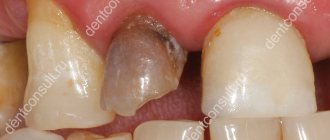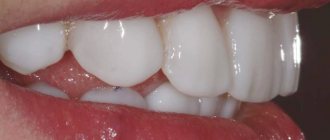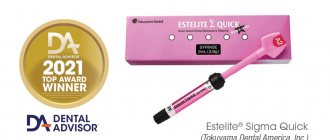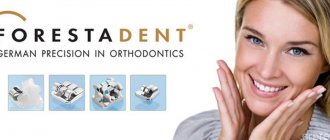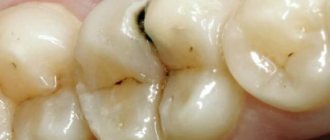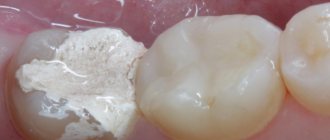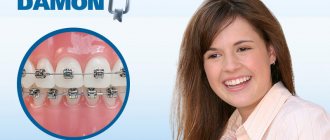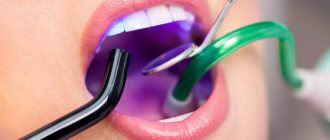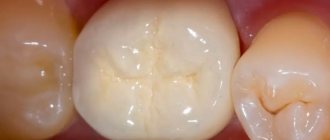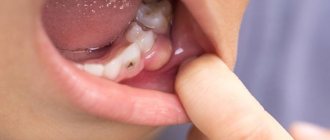2488
Spectrum is the newest development in the world of photopolymer hybrid universal materials for eliminating defects on the chewing and frontal elements of the dentition.
Non-toxic composite allows you to install long-lasting fillings.
Spectrum filling material has excellent polishability and mirror-like shine. Used in aesthetic dentistry.
System components
Spectrum is used for the restoration of chewing teeth, as it can withstand heavy loads.
The front teeth are also filled with composite. The material is endowed with “chameleon” properties, allowing you to achieve a perfect match to the color and transparency of the tooth being restored.
The selection of shade can be done using the Vita scale. Perfect filling is achieved in the simplest way.
The role of the filler (57% of the total volume) in the composite will be played by barium glass, as well as sintered silicon. The microparticles of this filler are very small in size - 0.8 microns.
This feature allows for high-quality polishing of the finished surface to a shine. Characterized by a high degree of marginal fit. The likelihood of cracks, chips, and the development of recurrent caries is very low.
Available in the form of syringes (4.5 g) or ready-made compules (0.25 g).
"Spectrum" set in syringes includes:
- 6 syringes of 4.5 grams of various shades (A3, A2, A3.5, O-A3.5 O-A2, B2);
- 1 Prime & Bond 4.5 ml;
- 25 pcs. application needles;
- 50 pcs. applicators;
- 1 PC. DETREY conditioner 3 ml;
- 1 instructions.
"Spectrum" set in compules:
- 52 pcs. Compule 0.25 g;
- 1 PC. pistol for using compule;
- 1 tube Prime & Bond 4.5 ml;
- 50 pcs. applicators;
- 1 PC. Shade Guide;
- 1 PC. DETREY conditioner 3 ml;
- 25 pcs. application needles;
- 1 instructions.
Features of the component sets:
- blue gel conditioner
- Prime & Bond is both a primer and an adhesive that simplifies the treatment procedure and guarantees excellent adhesion and good marginal seal;
- an applicator gun is a device that allows you to carefully apply the composite into the cavity;
- Illustrated instructions help to perform fillings correctly;
- The syringe caps are colored according to the Vita scale and help dentists choose the right shade.
Compound:
- Base: urethane modification Bis-GMA
- Filler: barium glass and silicon dioxide
- Main filler size: <1um
- Filler content by weight: 77%
- Filler content by volume: 57%
- Compressive strength: 383 MPa
- Diametric strength: 71 MPa
- Transverse strength; 145 MPa
- Modulus of elasticity: 10.572 MPa
- Water absorption: 12um/mm3
- Visible opacity: 30 - incisal shade 41 - standard shade 50 - opaque shade
- Radiopacity: 3 mm aluminum
Indications and contraindications
Recommended for the restoration of all types of dental elements, both anterior and lateral. Used exclusively in dentistry.
Spectrum is contraindicated in patients allergic to methacrylate or acrylate plastics. To prevent irritation, it is important to avoid contact with eyes, mucous membranes or skin. If contact occurs, the area must be immediately washed with water.
Advantages
Spectrum is designed for the combined use of DETREY conditioner and Prime&Bond adhesive. With their help, dentin and enamel are prepared for applying a filling agent in one step.
The duration of the dental procedure, as well as the amount of materials used, is significantly reduced. At the same time, the quality of work is high.
The advantage of the composite for the patient:
- cannot be distinguished from a natural tooth by color;
- maximum degree of marginal fit, and this property reduces the likelihood of recurrent caries;
- excellent durability, low likelihood of abrasion;
- after polishing, the restored units do not differ from the shine and appearance of natural enamel;
- fast and efficient procedure;
- There is no discomfort during dental procedures.
Advantages of the material for the dentist:
- reliable and easy to use;
- the components of the kit facilitate the work of filling teeth;
- color identification of the caps allows you to use the product correctly;
- perfectly modeled and polished;
- has a creamy consistency and does not stick to instruments;
- Dental restoration using filling material allows you to create a durable filling that is similar in color to natural teeth.
How durable is a cement filling on a tooth and what determines its service life.
Come here to learn more about depophoresis in dentistry - what it is and for what purpose it is performed.
At this address https://www.vash-dentist.ru/lechenie/zubyi/razvitiya-i-taktika-flegmonyi.html read why phlegmon can develop after tooth extraction.
General information
The organization has existed for more than a hundred years, its specialization is the production of dental products. are located in thirty-eight countries, and also in Germany, where they produce Spectrum filling material.
Dental consumables are sold in one hundred and twenty countries on the planet. The ingredients of the Spectrum system are used to restore chewing teeth, as they can withstand enormous loads. The front teeth are filled with composite. The specific properties of the material are “chameleon”, which allows you to achieve the ideal balance of color and transparency of the tooth being restored.
It is possible to select a shade using the Vita scale. Fifty-seven percent of the filler in the composite is barium glass, sintered silicon. The microscopic particles of this filler have tiny sizes - eight tenths of a micron. This feature helps to carry out high-quality polishing of an already prepared surface to a shine and fits perfectly along the edges. The chance for cracks, chips, and the development of recurrent caries is minimal.
Warnings
Precautionary measures:
- syringes must be tightly closed after use;
- do not allow the filling substance to come into contact with blood or saliva, use a rubber dam;
- It is easy to squeeze the material out of the capsules;
- do not use hydrogen peroxide;
- Before use, remove from the refrigerator and warm to room temperature;
- Do not apply conditioner to hard tissue in close proximity to the pulp;
- Do not allow Prime & Bond to get into the gum cords.
Mode of application
"Spectrum" is applied in stages:
- First, the cavity is prepared for filling, the tooth is isolated from saliva.
- The shade of the composite is selected.
- Then acid etching is carried out.
- The gasket is inserted.
- Bonding is carried out and the composite is introduced in small portions into the already fully prepared cavity.
With the help of light, the soft filling material hardens. Excess filling material is removed with diamond burs, and the filling itself is processed to create the relief characteristic of the tooth.
Control of contact between the filled tooth and its antagonist is carried out using carbon paper. Final processing is carried out with a polishing gum, discs, and special paste.
Selecting a shade
Before the filling process, a shade is selected. Teeth should be moisturized. A special paste and water removes plaque or pigmentation from the surface.
When selecting a shade, you need to use the color standard included in the set. It contains samples of restoration material of different colors.
The tone of the marking dot on the template matches the tone of the syringe label. You can also use the standard Vita scale.
It is important to ensure that the shade scale does not become dirty. In order to determine the color of the tooth, you need to remove the desired shade from the holder. After use, color analogues need to be processed.
Preparation of cavities (front, lateral teeth)
Stages of work:
- Clean the tooth surface with a prophylactic paste that does not contain fluoride.
- Prepare cavities of class 3-5 of the anterior teeth for composite, prepare them for acid etching. Preserve healthy tooth tissue.
- To fill lateral teeth, before acid etching, prepare the carious cavity and carefully process the edges.
There should be no foreign matter or amalgam in the cavity. Otherwise, polymerization of the filling material will not occur.
Humidification control
For successful adhesion, the cavity must be kept clean. Do not allow saliva, blood or gum fluid to get into the prepared tooth.
It is necessary to insulate using rubber dam. The surface is washed with water, then its excess is removed. Do not allow tooth tissue to dry out.
Purpose of retraction thread in dentistry and its varieties.
This publication contains details about the technique of intraligamentary anesthesia.
Here https://www.vash-dentist.ru/lechenie/zubyi/vseh-nyuansah-pod-mikroskopom.html we will talk about the benefits of treating a dental cyst under a microscope.
Pulp isolation
If a deep cavity has formed during the treatment of caries, then calcium hydroxide should be used as a cushioning material .
The rest of the surface is treated with Prime & Bond. Glass ionomer cement can be used as a liner.
Matrix overlay and pre-processing
A matrix is installed on the prepared cavity, and a wedge is inserted between adjacent teeth. The matrix is necessary for separating adjacent contacting surfaces of teeth and contouring fillings. It is recommended to pre-install a BiTine steel ring for restoration of posterior teeth.
DETREY conditioner is used for cavity etching. Prime & Bond is used to bond the composite to enamel and dentin.
Treated surfaces must not become dirty. The filling material must be applied immediately.
Application and polymerization
After adding the adhesive, you need to add the composite into the cavity in portions. The thickness of each layer should be no more than 3 mm.
Each layer is irradiated with a photopolymerizer. During polymerization, each layer of the composite must be irradiated for 20 seconds.
The filling is additionally irradiated through the lingual and buccal enamel walls. If a pin is used, the composite is polymerized around it in layers.
Finishing
After polymerization, the final processing of the filling begins. Excess material is removed using diamond burs.
Surface polishing is done using Enhance polishing discs. Gloss is achieved using Prisma Gloss paste.
Dental composite materials (composites)
Dental composites today are the main class of restorative (filling) material. The advantages of composites over many other filling materials are their high strength, which allows them to be used in any clinical situations (both on anterior and chewing teeth); high and flexible aesthetic characteristics that allow you to manipulate the color of restorations and their gloss over a wide range of values; high technology when performing restorations; minimal polymerization shrinkage.
However, composites, even with the maximum content of inorganic filler, still have some shrinkage during curing, a fairly high coefficient of thermal expansion and less rigidity than that of dental tissues. These disadvantages of composites contribute to the appearance of marginal gaps between the filling and the dental surface, leakage of oral fluids through these gaps and, as a result, depressurization of the cavity. This leads either to the loss of the filling (damage to the restoration) or to the development of secondary caries. The disadvantages of composites are eliminated by the use of adhesives (adhesive systems ensure “gluing” of the composite to dental tissue) or other techniques. Therefore, polymerization shrinkage of dental composites is currently not a problem in restorative dentistry.
By definition, a composite material is a mixture of several dissimilar components. In the case of dental composites, it is a mixture of filler (usually inorganic) and an organic matrix, and the filler content is very significant (at least 30% by volume; with a lower filler content, the material is usually classified as a “low-filled polymer”).
Additional components of the organic matrix (in the initial state) are a polymer inhibitor (to increase the curing time and shelf life of the material), a catalyst (in the case of chemically cured composites; a separate component in the form of a paste or liquid), a photoinitiator (in the case of light-cured composites), an accelerator polymerization (in chemically cured composites), ultraviolet light absorber (to improve light stability) and dyes.
Typical fillers for dental composites are amorphous silica, quartz, barium glass, strontium glass, zirconium silicate, titanium silicate, oxides and salts of other heavy metals, and polymer particles. Modern technologies for the production and introduction of fillers include: improved grinding technologies to produce smaller particles; technologies for producing chemically deposited filler particles (the so-called sol-gel process; allows you to obtain filler hybrids); strengthening of composites with fibers (reinforcement; but this leads to a decrease in the transparency of the composite); introduction of porous (chemically deposited) fillers and three-dimensional structures (to reduce shrinkage stress); introduction of fillers with anti-caries properties (primarily those that release fluoride; however, the limitation is the low permeability of the organic matrix of the composite); technologies for modifying the surface of filler particles to allow copolymerization with an organic matrix (for example, alkoxysilanes); nanotechnology.
The size and amount of filler are the basis of the most common classification of dental composites. Based on the size of filler particles, composites are distinguished: macrofilled, macrophiles (10-100 microns); midin-filled (1-10 microns); mini-filled (0.1-1 microns) micro-filled, microphiles (0.01-0.1 microns); hybrid (contain macro- and microparticles); heterogeneous (conventional or hybrid composites with additives of particles of polymer material 1-20 microns in size).
Based on the content of filler particles (the degree of filling of the dental composite), highly filled composites (more than 60% by volume), medium-filled composites (40-60% by volume) and lightly filled composites (30-40% by volume) are distinguished. The polishability, abrasion resistance and color stability of the dental composite depend on the size of the filler particles. Strength, degree of thermal expansion and polymerization shrinkage depend on the degree of filling.
Recently, so-called nanocomposites have been identified among dental composites, which can be conditionally considered as hybrid microphilic (microhybrid) materials. In nanocomposites, “nanosized” particles (nanomers), which have a size of up to 0.1 μm (100 nm), are used as fillers. Nanomers tend to aggregate to form nanoclusters, so in reality a nanocomposite contains a mixture of nanomers and nanoclusters as a filler. Nanoclusters behave like individual particles, and modern technologies make it possible to control their size and shape. As a result of combining nanometers and nanoclusters in one material, the material has a high fullness (more than 75%), which ensures high strength. In conventional hybrid dental composites, during the process of abrasion, strong filler particles leave the surface and leave behind “craters,” which reduces the shine of the restoration or filling. In the case of abrasion of nanocomposites, nanoclusters are removed not entirely, but their smaller components, which allows the nanocomposite to have a more durable shine and good polishability. Nanocomposites of the latest generations (for example, Estet-X) contain three filler phases: nanoparticles, midiparticles phase and miniparticles phase. The ratio of the three phases is strictly dosed. The name “micromatrix” has been proposed for such nanocomposites.
The basis of the organic matrix of dental composites (before the stage of their curing) are monomers, the molecules of which contain fragments of epoxy resin and two methacrylate groups. It is known that methacrylic acid and its derivatives easily enter into polymerization reactions (for example, with the formation of polymethyl methacrylate, which is usually called “plexiglass”), and the reaction proceeds by a free radical mechanism. The first monomer of this type was patented back in 1959 (GMA monomer) and since then GMA and its derivatives have been included in almost all modern dental composites and adhesives. The reason for the dominance of monomers of this type is the relatively low polymerization shrinkage (about 6% in pure form), rapid curing, low volatility, and good mechanical characteristics of the final polymer.
Polymerization initiators are substances that generate free radicals when exposed to light or chemically. Therefore, according to the polymerization (curing) method, dental composites are divided into light-curing composites (light-composites, photo-composites, gel-composites) and chemical-curing composites (self-curing).
Chemically cured dental composites are either paste-paste or powder-liquid systems. The reaction that initiates polymerization (curing) is the interaction (after mixing the starting components) of the amine and benzoyl peroxide with the formation of free radicals. The rate of polymerization depends on the number of initiators, temperature and the presence of inhibitors. The main advantage of such dental composites is uniform curing, regardless of cavity depth and filling size.
Light-curing dental composites are a one-component initial form (paste or flowable material). A light-absorbing substance (photoinitiator; the most traditional is camphoroquinine, maximum absorption spectrum is 475 nm), which, when absorbing light with a wavelength of 400-500 nm (blue light), forms free radicals, is used as an initiator of polymerization (curing). Light composites do not require mixing (therefore they are more homogeneous), they allow modeling of the restoration (filling) before light curing, and the absence of chemically active additives (the absence of amines) gives them color stability and aesthetics. However, it should be taken into account that the degree and depth of polymerization may be non-uniform and depends, first of all, on the transparency and color of the composite, and the power of the light source. Typically, layer-by-layer application and curing of the dental composite is carried out, which makes it possible to reduce shrinkage and stress in the matrix and more accurately select the color of the restoration (filling).
The light source for curing dental composites is usually conventional halogen lamps (halogen photopolymerizers). Their disadvantages are the small “useful” component of radiation (less than 2%), the need to use an interference filter that cuts off stray thermal radiation, and a fan (to remove heat). Recently, emitting LEDs are increasingly used as light sources, the emission spectrum of which practically coincides with the absorption spectrum of camphoroquinone, and which do not have all the disadvantages of halogen lamps.
A separate group of dental composites with which teeth are filled are restoration (filling) materials of a “hybrid” type – compomers.
Compomers are light-curing restoration (filling) materials that combine the main advantages of composites (ease of use, strength, aesthetic properties) and glass ionomer cements (chemical adhesion to tooth tissue, good biocompatibility, fluoride release). The term “compomer” comes from a combination of the words COMPOSITE and glass ionomer. The initial (before polymerization) organic matrix of compomers is a monomer (acid methacrylate), the molecule of which contains methacrylate (like a composite) and acid (like glass ionomer cement) groups. Compomer fillers are fluoroalumosilicate glass particles. Acid methacrylates can simultaneously cure by the free radical mechanism (as in the case of polymerization of light-curing composites) and by the ion exchange mechanism (as in the case of glass ionomer cements). Curing of compomers occurs only due to light-induced polymerization. Curing similar to glass ionomer cements (requiring the presence of water to dissociate acid groups) occurs only in areas of the material in contact with water.
Compomers differ from classical hybrid glass ionomer cements modified (reinforced) with composites. In the latter, the ion exchange reaction, which initiates the curing of the material, is the dominant part of the entire curing process. In contrast, compomers are materials that contain the main components of glass ionomer cements in quantities insufficient to maintain the ion exchange reaction under normal (anhydrous) conditions. Although compomers were developed to combine the best properties of resin composites and glass ionomer cements, their behavior is more similar to that of dental composites.
Disregarding the basic physical and chemical characteristics of materials, the entire range of modern dental composites, according to the features of their application, can be divided into 5 main groups.
- Universal composites with one-color color restoration concept. This group includes almost all chemically cured composites and some light-cured composites.
Charisma PPF. Chemically cured composite material. Used for filling, restoration of the crown part of the tooth, fixation of mobile teeth.
Ceram X. Light-curing nanocomposite for small restorations (fillings) of chewing teeth. The material has been optimized for highly aesthetic restorations with a minimum number of shades.
- Versatile composites with a two-layer color reproduction concept. Such composites (restorative systems) include one or more dentins, which provide the creation of the internal structure of the tooth, and a set of enamel shades (including a transparent cutting edge), which ensures the refraction of light on the tooth surface. These materials make it possible to achieve fairly high results in the restoration of anterior and chewing teeth, but still somewhat limit the creative possibilities of the dentist in reproducing color.
Filtek Z 250 (Filtek Z 250). Aesthetic light-curing microhybrid composite. Contains an increased amount of smaller particles. It is used for filling cavities of all types in the frontal and chewing teeth, making veneers, restoring the coronal part of the tooth, and splinting. Has 15 different shades.
Spectrum TPH. Light-curing microhybrid composite. The filler (barium glass and sintered silicon) has 2 fractions of 0.04-0.4 microns and 0.8-1 microns with a filling of 55-60% by volume. Due to the successful combination of aesthetic and mechanical properties, they are used for restoration (filling) of all types of defects in hard dental tissues. An entire generation of dentists grew up on this material and mastered the basics of cosmetic restoration techniques.
- Restoration materials with a three-layer color reproduction concept. Restoration (filling) materials of this group are “artistic” systems. The range of shades includes a wide range of opane (opaque) dentin shades, basic tooth body shades and a set of transparent enamels.
Estet-X. Light-curing micromatrix composite material. The filler is presented in the form of three phases (up to 2.5 microns, 0.4-0.8 microns and nanoparticles 0.01-0.02 microns), the ratio of which is strictly dosed. Has extremely high aesthetic capabilities. Used by dentists who focus primarily on achieving high aesthetic results. With the same strength and color stability as, for example, Spectrum TRN, it is washed 3 times less, does not require updating the gloss and has 2 times less shrinkage (which justifies the high cost of this material).
Filtek Supreme. Light-curing nanocomposite material. The filler (zirconium silicate) is presented in the form of nanoparticles (0.02-0.75 microns in size) and nanoclusters. The technology allows you to control the size of nanoclusters (create a given size) and in this way influence the strength, polishability and polymerization shrinkage of the material. A universal restoration (filling) material that combines the mechanical properties of microhybrids and the aesthetics of microfills.
The choice of a dentist in favor of a specific material from these three groups is associated with a combination of several factors (price of the material, cost of work, time spent working with the patient and the qualifications of the doctor, the final aesthetic result). For relatively simple restoration (filling), dental composites of the 1st and 2nd groups are predominantly used. If the dentist is not very limited in time, and his patient is less limited in funds, he can use materials of the 3rd group, which provide him with wider opportunities.
- Dental composite materials for restoration (filling) of chewing teeth. The main requirements are high resistance to abrasion and deformation under chewing load.
Quixfil. A light-curing composite material designed specifically for restoration (filling) of chewing teeth. It has a high (30% greater than most other composites) fullness, due to which it has increased hardness and low polymerization shrinkage. The filler (glass) is presented in the form of two fractions: 1 and 10 microns. A specially developed organic matrix (monomer) provides a large depth of polymerization (the thickness of the polymerized layer is up to 2.5 mm). The high level of transparency of the material makes the restorations (fillings) slightly different from natural enamel, which makes it easy to determine the location of the material in complex restorations of lateral teeth. Has one universal shade.
- Liquid-flowing composite materials. Used for filling small cavities, fissures, and cervical defects using the minimal intervention technique. For small cavities, shrinkage and subsequent marginal permeability are not as important as for large cavities, so flowable materials are optimal for adapting the restorative material to the cavity. All fluid-flowing composites are classified as medium- and lightly filled (filler content less than 47%). Liquid-flowing composites have the property of thixotropy (fluid under the influence of instrument load and viscous after the load is removed), therefore, before polymerization, they do not flow beyond the boundaries of the cavity, even on the teeth of the upper jaw. Another important property of flowable composites is their low modulus of elasticity. This allows them to compensate for the stress that occurs under the influence of chewing load at the “filling-tooth” border (which is especially important when restoring cervical defects).
X-flow. A universal, flowable, light-curing composite. Adapts to cavity walls without the use of hand tools. The filler (38% by volume, particles 1.6 microns in size) is represented by special glass, highly dispersed silicon dioxide, titanium dioxide. Used for filling small cavities of anterior and lateral teeth (without chewing load), sealing fissures, and restoring shallow cervical defects. Can be used for fixation of orthopedic structures (for example, indirect veneers), provided there is light access to the tooth/restoration interface. Has a number of shades.
Filtek Flow. Liquid-flowing light-curing composite. Filler content is 47% by volume, particle diameter is 1.4-1.6 microns. It has high wear resistance and is compatible with other composites. Has a number of shades.
Dyract Seal. Light-curing compomer material (sealant), developed specifically for filling (sealing) fissures. Thanks to its good fluidity and ideal wetting ability, it penetrates deeply into recesses and fissures and ensures a high-quality marginal seal. Abrasion resistant. Being a compomer, it releases active fluoride for a long time, which provides additional protection for dental tissues.
Make an appointment with the best dentists in Moscow!
Reviews
Many dentists claim that the material has a predictable result. It is easy and quick to work with, it is flexible and durable.
If you have had to work with the system or test the Spectrum filling on your teeth, leave a review on the site.
If you find an error, please select a piece of text and press Ctrl+Enter.
Tags treatment filling Spectrum fillings
Did you like the article? stay tuned
Previous article
When is dental retreatment required and how does it happen?
Next article
Parapulpal pin as one of the ways to restore a severely damaged tooth
